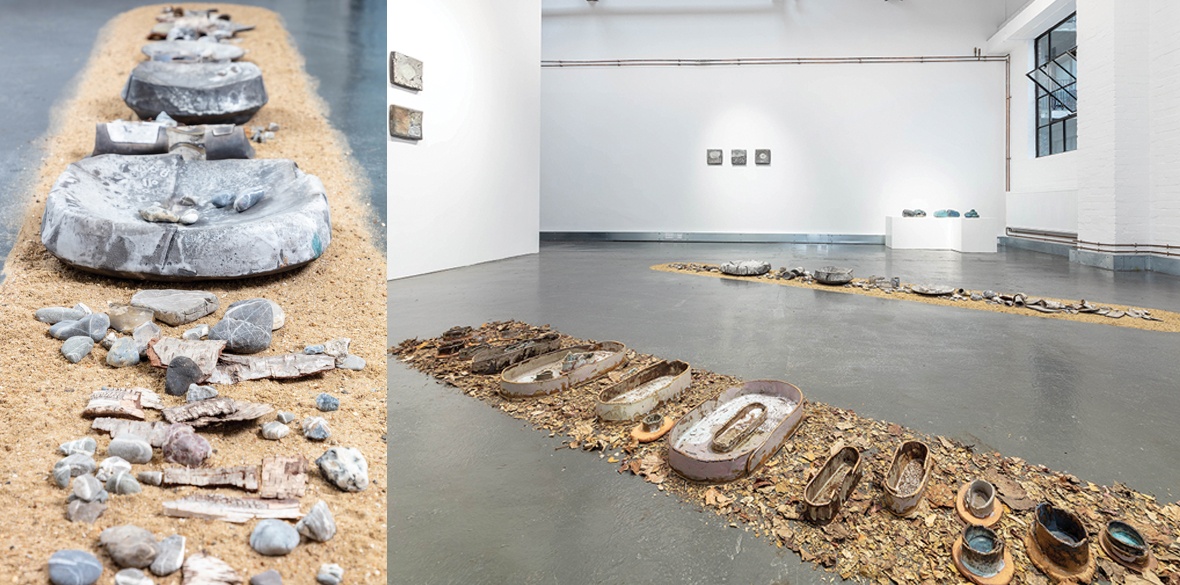This is the last article you can read this month
You can read more article this month
You can read more articles this month
Sorry your limit is up for this month
Reset on:
Please help support the Morning Star by subscribing here
Marta Jakobovits
Look and See
Elizabeth Xi Bauer Gallery, London
WHO hasn’t a beachcomber lurking inside that’s released, like Alladin’s genie tempting with serendipitous wishes, as soon as our bare feet touch marine sand somewhere?
Romanian Marta Jakobovits imbues fact with wonder. Her ceramic work, despite its formal rigour is entirely emotive and poetic.
The visual association with depositions brought by the sea, or an imaginary archaeological dig where “unearthed” artefacts, neatly lined out, pique our curiosity and invite childlike squatting for a closer inspection.
Such is the installation Part of the Road Travelled, 2014–2016, consisting of 33 pieces of ceramics, sand and stones which set the imagination flying.
Vestigial vessels, pottery fragments, some, like Turquoise Hills, 2002 — enigmatic amulets perhaps — covered in an Egyptian-blue glaze intrigue as much as they please aesthetically.
Clay is, for all we know, the most ancient of art materials and the oldest known clay artefact, the Venus of Dolni Vestonice, was fired at low temperatures around 31,000 years ago.
But humankind’s association with clay is as primordial as can be given that most creation myths record us as being made from lumps of clay by a variety of gods from the Sumerian Enki to the Greek Prometheus, from the Chinese Nuwa to the Inca Viracocha or Yoruba Obatala to Maori Tane Mahuta.
Clay was globalised in the neolithic period when it was extensively used for a myriad of purposes throughout the planet.
Jakobovits’s fascination with this material is atavistic as she confides: “The instinctive, sensory way of touching and feeling clay connects me strongly to the primal messages of the material. Ceramics is a special means of approaching the deep secrets of our existence; for me, ceramics is a special language.”
There is, however, a limit to what her ceramics reveal through the simplicity of their form and their rudimentarily articulated purpose. Not even the intuitive Jakobovits knows “the shadow of her imagination on this Earth,” in the words of Vladimir Nabokov.
In 2018 Jakobovits accepted an invitation to hold workshops in Tehran and Isfahan in Iran, as part of the Rah Art Residencies. Such direct contact with ancient and contemporary Persian arts was an ideal environment in which to evolve her interest in the inner secrets of the cuneiform ceramic tablets of ancient Mesopotamia, that once were part of the Assyrian king Ashurbanipal’s library but are now... in possession of the British Museum.
Her resulting work My Library, which mimics — not without deep irony — the British Museum display, pays homage to said Ashurbanipal’s library, making a subtle political point.
The 2021 installation Collecting the Raindrops consist of 23 elemental ceramic vessels and dried leaves, perhaps, an invocation of an ancient civilisation’s long abandoned supplication for rain — a poignant allusion to the accelerating deathly climate change.
Jakobovits’s formal modesty offers intimacy and invites reflection and, by blending abstraction and realism, it speaks with a language full of reassuring familiarity. And that is an achievement worthy of undivided attention.
Until November 30 2022. Free.









